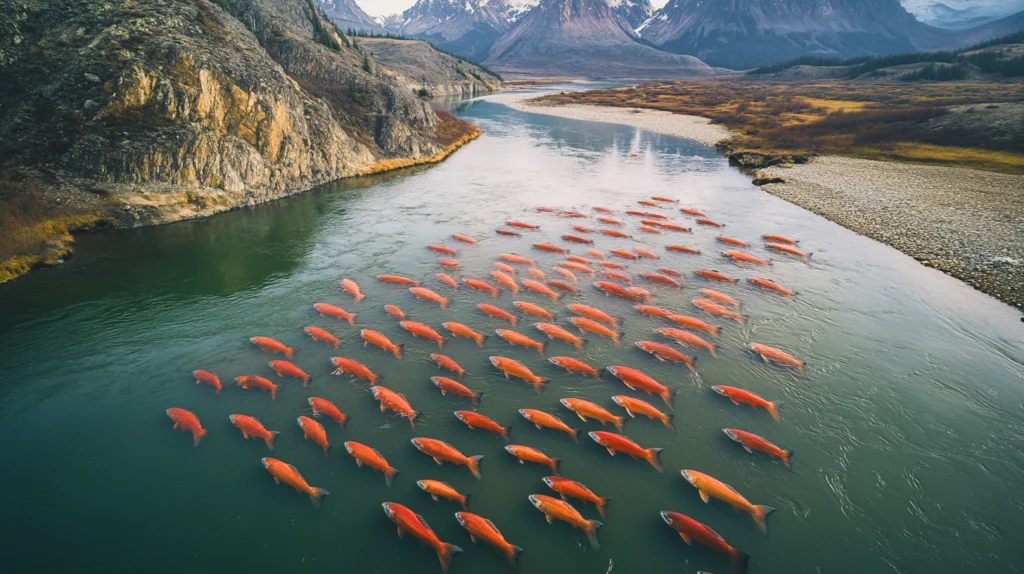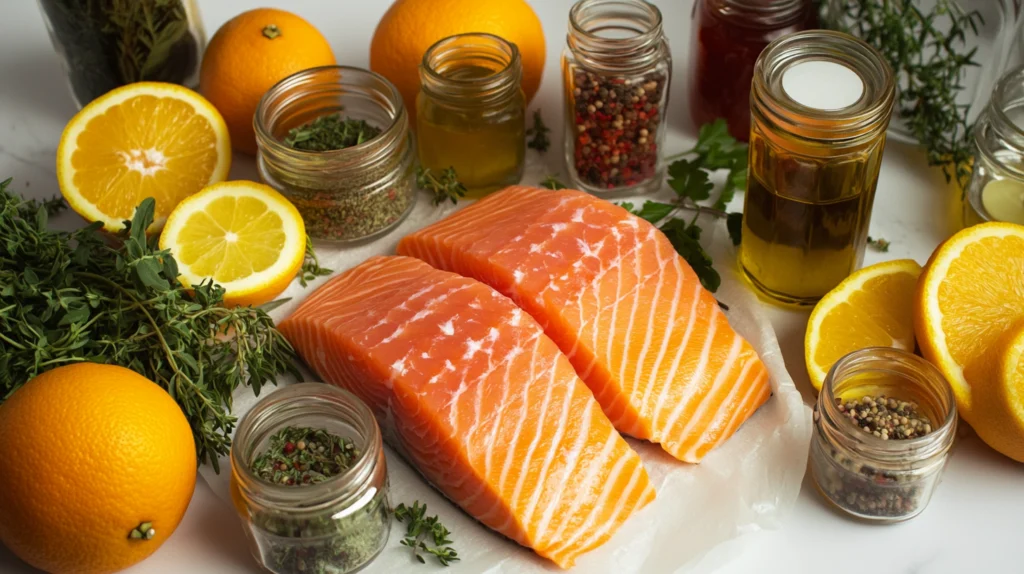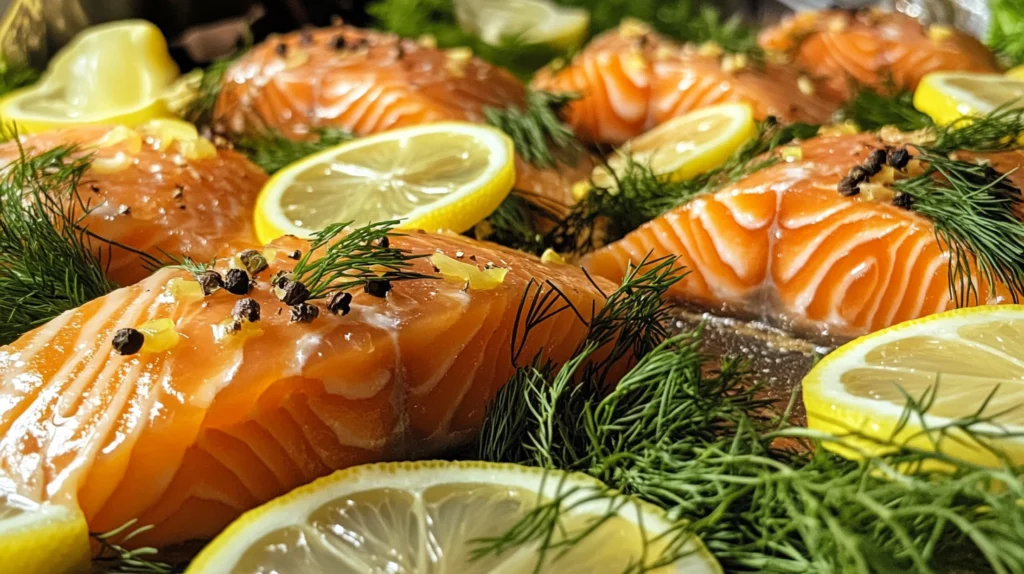Outline and Introduction
Introduction
Looking for the perfect Copper River salmon recipe? This prized fish, renowned for its rich, buttery flavor and vibrant red color, is a culinary treasure from Alaska’s pristine waters. With its high oil content and short seasonal availability, Copper River salmon is both a gourmet delight and a nutritional powerhouse. In this article, we’ll explore a variety of recipes that highlight its unique qualities, helping you create mouthwatering dishes at home. In this article, we will guide you through the best ways to prepare Copper River salmon. You will learn everything from simple grilling techniques to creative dishes that promise to delight your taste buds.
Understanding Copper River Salmon
What Makes Copper River Salmon Special?
Copper River salmon is not just any fish; it’s a culinary treasure. It comes from the Copper River in Alaska, where the salmon swim upstream to spawn. This challenging journey requires the fish to store large amounts of energy in the form of healthy fats. These fats, combined with the fish’s pristine diet of marine nutrients, give the salmon its rich, buttery flavor and vibrant red color.
The Copper River’s cold, swift waters contribute to the salmon’s firm texture. These fish are exceptionally robust, with a flavor profile that sets them apart from other salmon species. They are only available during a short season, typically from May to mid-June, making them a highly sought-after delicacy.
King Salmon Recipe
This article explores another type of salmon recipe with detailed preparation tips. Linking this provides a broader perspective on salmon cooking techniques.
Types of Copper River Salmon
Copper River salmon includes three main species:
- King Salmon (Chinook): The largest and richest variety, known for its high oil content and velvety texture.
- Sockeye Salmon (Red): Smaller than King salmon, Sockeye has a deep red color and a bold, robust flavor.
- Coho Salmon (Silver): Milder and less fatty, Coho is versatile and pairs well with a variety of seasonings.
Each type of Copper River salmon has unique characteristics, but all share the exceptional quality that food enthusiasts rave about.
Sustainability and Responsible Fishing
Alaska takes great pride in sustainable fishing practices. Authorities carefully manage the Copper River salmon fishery to ensure the population thrives. Fishermen adhere to strict guidelines to maintain environmental balance, allowing future generations to enjoy this prized fish.
The Health Benefits of Copper River Salmon
This salmon is not only delicious but also packed with nutrients. It provides an excellent source of omega-3 fatty acids, which support heart health, brain function, and inflammation reduction. A single serving also offers a substantial amount of protein, along with essential vitamins like B12, D, and selenium. Including Copper River salmon in your diet can enhance your overall well-being while indulging in gourmet flavors.

Key Ingredients to Enhance Flavor
Essential Ingredients for Copper River Salmon Recipes
Cooking Copper River salmon is all about highlighting its natural flavors. Its rich, buttery taste pairs well with a variety of ingredients, but simplicity often works best. Below are some essential ingredients that can elevate your Copper River salmon dishes:
- Citrus:
Lemons, limes, and oranges add brightness and acidity to balance the salmon’s richness. A simple squeeze of lemon can work wonders for enhancing flavor. - Fresh Herbs:
Dill, parsley, chives, and cilantro complement the salmon’s taste. Herb mixtures can be used as garnishes or blended into marinades. - Garlic and Shallots:
These aromatic ingredients create depth and complexity in dishes, whether roasted, minced, or sautéed. - Olive Oil or Butter:
High-quality olive oil or melted butter keeps the salmon moist and infuses it with a luxurious texture. - Spices:
Salt, black pepper, paprika, and cayenne pepper bring out the fish’s natural flavors without overpowering them. For a more exotic touch, try cumin, coriander, or turmeric. - Marinades and Sauces:
Soy sauce, honey, maple syrup, Dijon mustard, and balsamic vinegar create versatile marinades. These ingredients add sweet and savory notes to your dish. - Vegetables:
Side vegetables such as asparagus, zucchini, or cherry tomatoes pair beautifully with salmon. Roasted or grilled vegetables enhance the meal with complementary textures and flavors.
Flavor Profiles Based on Cooking Method
The way you cook Copper River salmon can also influence its flavor:
- Grilled Salmon: Smoky and charred, best with bold marinades like soy-ginger or Cajun rubs.
- Baked Salmon: Retains moisture well and works wonderfully with herbs and citrus.
- Pan-Seared Salmon: Develops a crispy, golden crust, which pairs well with butter and garlic.
Popular Pairings with Copper River Salmon
Pairing the right sides and accompaniments can take your dish to the next level. Consider these options:
- Grains: Quinoa, wild rice, or couscous add texture and substance.
- Salads: Light salads with arugula, spinach, or kale balance the richness of the salmon.
- Pasta: Creamy or lemon-based pasta dishes complement salmon beautifully.

Preparation Techniques
Step-by-Step Guide to Preparing Copper River Salmon
Before cooking Copper River salmon, proper preparation ensures the best flavor and texture. Follow these steps to prepare your salmon perfectly:
- Check for Freshness:
Look for salmon with vibrant, deep red flesh and no fishy odor. If frozen, thaw the fish in the refrigerator overnight. - Remove the Skin (Optional):
Although the skin is edible and delicious when crisped, some recipes require its removal. Use a sharp fillet knife to separate the skin from the flesh by gently sliding the blade along the edge while holding the skin taut. - Debone the Salmon:
Run your fingers along the fillet to detect any pin bones. Use kitchen tweezers to remove these bones carefully. - Pat Dry:
Use paper towels to pat the salmon dry. Removing excess moisture helps the fish develop a golden crust when cooked. - Season or Marinate:
Depending on the recipe, you can season the salmon with salt, pepper, and herbs or marinate it for 15–30 minutes to enhance the flavor. Avoid over-marinating, as the acid in citrus or vinegar can start breaking down the fish’s texture.
Preparation Methods Based on Cooking Style
1. Grilling:
- Tip: Brush the fish with olive oil to prevent sticking.
- Preheat the grill to medium-high heat. Place the salmon skin-side down on the grates, close the lid, and cook for 4–6 minutes per side.
2. Baking:
- Tip: Use parchment paper or aluminum foil for easy cleanup and moist results.
- Preheat the oven to 375°F (190°C). Place the seasoned salmon on a baking sheet and bake for 12–15 minutes.
3. Pan-Searing:
- Tip: Let the salmon come to room temperature before cooking for even results.
- Heat a skillet over medium-high heat. Add a tablespoon of olive oil or butter. Place the salmon skin-side down and cook for 4–5 minutes, then flip and cook for another 2–3 minutes.
4. Poaching:
- Tip: Use a flavorful broth or court bouillon (water with herbs and aromatics).
- Bring the liquid to a gentle simmer. Submerge the salmon and cook for 10–12 minutes until tender.
Common Mistakes to Avoid
- Overcooking: Salmon is best when cooked to an internal temperature of 125–130°F (52–54°C) for medium-rare. Use a meat thermometer for precision.
- Skipping Rest Time: Allow the fish to rest for 3–5 minutes after cooking to redistribute the juices.
How to Enhance Presentation?
To elevate the visual appeal of your dish, garnish the salmon with fresh herbs, lemon wedges, or a sprinkle of sea salt. Serve on a clean, white plate for a sophisticated look.

Grilled Copper River Salmon
Why Grilling Enhances Copper River Salmon?
Grilling is one of the best methods to cook Copper River salmon because it brings out the fish’s natural, smoky flavor while locking in its moisture. The slightly charred exterior provides a delightful contrast to the buttery, tender interior.
Ingredients
- 4 Copper River salmon fillets (6 oz each)
- 2 tablespoons olive oil
- 1 teaspoon sea salt
- 1 teaspoon freshly ground black pepper
- 2 garlic cloves, minced
- 1 tablespoon fresh dill, chopped
- 1 lemon (sliced into wedges)
Instructions
- Preheat the Grill:
Heat your grill to medium-high heat (about 375–400°F). Clean the grates thoroughly and brush with oil to prevent sticking. - Prepare the Salmon:
Pat the fillets dry with a paper towel. Brush both sides with olive oil and season with salt, pepper, and minced garlic. Sprinkle fresh dill evenly over the fillets. - Grill the Salmon:
Place the salmon fillets skin-side down on the grill. Close the lid and cook for 4–6 minutes. The skin should crisp up, and the salmon will start to turn opaque. Carefully flip the fillets using a spatula and grill the flesh side for another 2–3 minutes. Avoid overcooking, as the fish will continue to cook slightly after being removed from the grill. - Check for Doneness:
Use a meat thermometer to ensure the internal temperature of the thickest part reaches 125–130°F for medium-rare. The fish should flake easily with a fork. - Serve and Enjoy:
Transfer the grilled salmon to a serving platter. Garnish with lemon wedges and additional dill if desired. Serve immediately with your favorite sides, such as grilled asparagus or a light quinoa salad.
Tips for Perfect Grilled Salmon
- Use Cedar Planks: Soak a cedar plank in water for at least an hour and grill the salmon on the plank for added flavor.
- Marinate for Extra Flavor: Combine olive oil, soy sauce, honey, and ginger for a quick marinade that complements the salmon beautifully.
Copper River Salmon Teriyaki
Why Teriyaki Complements Copper River Salmon?
The sweetness and umami flavors of teriyaki sauce enhance the rich, buttery taste of Copper River salmon, making it a perfect pairing. This dish combines traditional Japanese flavors with the natural qualities of premium salmon for a restaurant-quality meal.
Ingredients
- 4 Copper River salmon fillets (6 oz each)
- 1/3 cup soy sauce
- 3 tablespoons honey or maple syrup
- 2 tablespoons mirin (or rice vinegar as a substitute)
- 1 tablespoon sesame oil
- 1 garlic clove, minced
- 1 teaspoon grated fresh ginger
- 1 teaspoon cornstarch (optional, for thickening)
- Sesame seeds and chopped scallions for garnish
Instructions
- Prepare the Teriyaki Sauce:
In a small saucepan, combine the soy sauce, honey, mirin, sesame oil, minced garlic, and grated ginger. Cook over medium heat for 3–4 minutes until the sauce begins to simmer. For a thicker sauce, dissolve 1 teaspoon of cornstarch in 1 tablespoon of water and stir it into the mixture. Allow the sauce to thicken for 1–2 minutes. Remove from heat and set aside. - Marinate the Salmon:
Place the salmon fillets in a shallow dish or resealable plastic bag. Pour half of the teriyaki sauce over the salmon, ensuring the fillets are evenly coated. Marinate in the refrigerator for 15–20 minutes. Reserve the remaining sauce for serving. - Cook the Salmon:
Heat a nonstick skillet or grill pan over medium-high heat. Lightly grease the pan with a small amount of sesame oil. Remove the salmon from the marinade (discarding the used marinade) and place the fillets skin-side down in the pan. Cook for 4–5 minutes until the skin is crispy. Flip the salmon carefully and cook the flesh side for another 2–3 minutes. The fish should be cooked through but still moist and tender. - Glaze and Serve:
Brush the reserved teriyaki sauce over the cooked salmon fillets. Sprinkle with sesame seeds and garnish with chopped scallions. Serve immediately over steamed rice or alongside stir-fried vegetables.
Variations and Customizations
- Teriyaki Baked Salmon: Preheat the oven to 375°F (190°C). Place marinated salmon on a lined baking sheet and bake for 12–15 minutes, brushing with additional sauce halfway through.
- Spicy Teriyaki: Add a teaspoon of Sriracha or chili flakes to the sauce for a spicy kick.
Nutritional Benefits
This dish not only offers incredible flavor but also provides a nutrient-rich meal. The salmon delivers heart-healthy omega-3 fatty acids and protein, while the ginger and garlic offer anti-inflammatory properties.
FAQs About Copper River Salmon
1. What makes Copper River salmon different from other types of salmon?
Copper River salmon stands out due to its high oil content, which gives it a rich, buttery flavor and vibrant red color. The fish come from the Copper River in Alaska, where they develop exceptional strength and fat reserves to endure their long migration upstream. This unique combination of factors makes Copper River salmon one of the most prized and flavorful varieties of wild salmon.
2. When is Copper River salmon in season?
The season for Copper River salmon is relatively short, typically running from mid-May to mid-June. The limited availability adds to its exclusivity and demand, so it’s a good idea to plan ahead to enjoy it during this brief window.
3. How should I store Copper River salmon?
For the best quality, keep fresh Copper River salmon in the coldest part of your refrigerator and use it within two days. If you need to store it longer, wrap the salmon tightly in freezer-safe packaging and freeze it for up to three months. Thaw frozen salmon in the refrigerator overnight for optimal results.
4. What is the best way to cook Copper River salmon?
Copper River salmon is incredibly versatile and can be grilled, baked, pan-seared, or poached. Each method has its benefits: grilling adds a smoky flavor, baking is low-maintenance, pan-searing creates a crispy texture, and poaching ensures tender, moist fish. The best method depends on your preference and available equipment.
5. Can I use frozen Copper River salmon for these recipes?
Yes, frozen Copper River salmon can be used for any of these recipes. Ensure that you thaw the fish properly in the refrigerator overnight before cooking. Once thawed, pat it dry to remove excess moisture before seasoning and cooking.
6. What are the nutritional benefits of Copper River salmon?
Copper River salmon is a nutritional powerhouse. It is rich in omega-3 fatty acids, which promote heart health and reduce inflammation, as well as high-quality protein, essential vitamins like B12 and D, and minerals such as selenium. Including Copper River salmon in your diet supports overall health while providing a gourmet dining experience.
Bonus Question:
7. Can I eat Copper River salmon raw in sushi or sashimi?
Yes, Copper River salmon is often considered safe for raw consumption if it has been properly handled and frozen to eliminate parasites. Always ensure you use sushi-grade salmon and consult your fishmonger about its suitability for raw preparation.
Conclusion
Copper River salmon is more than just a meal; it’s a culinary experience that celebrates the beauty of wild, sustainable seafood. With its short season and rich flavor profile, this prized fish is perfect for creating gourmet dishes at home. Whether you grill it, bake it, or enjoy it in a fresh salad, the unique taste of Copper River salmon shines through every recipe.
Take the time to source this incredible fish during its season and try the recipes shared here. From the smoky flavors of grilled salmon to the sweetness of teriyaki-glazed fillets, you can elevate your cooking and impress your guests with minimal effort. Don’t forget to pair your dish with complementary sides and a refreshing glass of wine for the ultimate dining experience.
Quick and Delicious Recipes
Suggest this page for readers seeking other quick meal ideas that complement their busy schedules.

